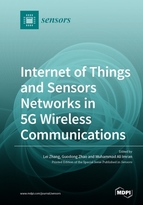Internet of Things and Sensors Networks in 5G Wireless Communications
A special issue of Sensors (ISSN 1424-8220). This special issue belongs to the section "Internet of Things".
Deadline for manuscript submissions: closed (30 September 2019) | Viewed by 56104
Special Issue Editors
Interests: distributed consensus; distributed systems; blockchain/distributed ledger technology (DLT); connected autonomous systems; Internet of Things (IoT)
Special Issues, Collections and Topics in MDPI journals
Interests: wireless communications; real-time control systems
Interests: 5G and Beyond networks
Special Issues, Collections and Topics in MDPI journals
Special Issue Information
Dear Colleagues,
Internet of Things (IoT) has attracted the attention of society, industry, and academia as a promising technology that can enhance day-to-day activities, the creation of new business models, and products and services, and as a broad source of research topics and ideas. It is envisioned that a future digital society will be composed of numerous wireless connected sensors and devices. Judging by this demand, massive IoT (mIoT) or massive machine-type communication (mMTC) has been identified as one of the three main communication scenarios for 5G. In addition to connectivity, computing and storage and data management are also long-standing issues for low-cost devices and sensors. The proposed Special Issue is anticipated as a collection of outstanding technical research and industrial papers covering new research results with a wide range of ingredients within the 5G-and-beyond framework. The main aim of this Special Issue is to provide a platform for the discussion of the major research challenges and achievements on this topic. Theoretical investigations as well as experiments/demos are welcome.
Potential topics include but are not limited to the following:
- Communication algorithms, protocols, standards, and architectures for IoT and sensor networks;
- Massive IoT/massive machine-type communication;
- Low power wide area (LPWA) technologies such as NB-IoT, Lora, etc;
- Sensor network and the applications to, e.g., healthcare/ wearable systems, and smart X;
- Security and privacy for IoT and sensor networks;
- IoT and SN hardware and new devices;
- Software for IoT and sensor networks;
- Wireless ad hoc Sensor networks;
- Routing and data transfer in IoT and SN;
- Computing and storage and data management for IoT and sensor networks;
- URLLC communications;
- Relay, D2D, Could-RAN, and cooperative networks;
- Resource management, network slicing;
- Autonomous systems and UAVs;
- Other related issues.
Dr. Lei Zhang
Dr. Guodong Zhao
Prof. Dr. Muhammad Ali Imran
Guest Editors
Manuscript Submission Information
Manuscripts should be submitted online at www.mdpi.com by registering and logging in to this website. Once you are registered, click here to go to the submission form. Manuscripts can be submitted until the deadline. All submissions that pass pre-check are peer-reviewed. Accepted papers will be published continuously in the journal (as soon as accepted) and will be listed together on the special issue website. Research articles, review articles as well as short communications are invited. For planned papers, a title and short abstract (about 100 words) can be sent to the Editorial Office for announcement on this website.
Submitted manuscripts should not have been published previously, nor be under consideration for publication elsewhere (except conference proceedings papers). All manuscripts are thoroughly refereed through a single-blind peer-review process. A guide for authors and other relevant information for submission of manuscripts is available on the Instructions for Authors page. Sensors is an international peer-reviewed open access semimonthly journal published by MDPI.
Please visit the Instructions for Authors page before submitting a manuscript. The Article Processing Charge (APC) for publication in this open access journal is 2600 CHF (Swiss Francs). Submitted papers should be well formatted and use good English. Authors may use MDPI's English editing service prior to publication or during author revisions.
Keywords
- IoT
- Sensor networks
- 5G
- mMTC
- URLLC
- Security








